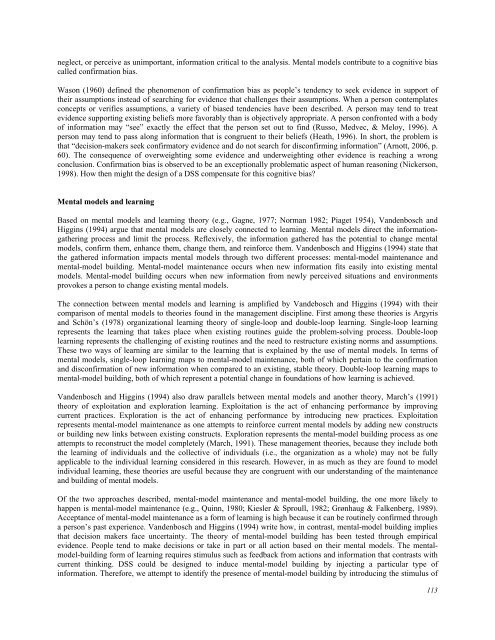October 2011 Volume 14 Number 4 - Educational Technology ...
October 2011 Volume 14 Number 4 - Educational Technology ...
October 2011 Volume 14 Number 4 - Educational Technology ...
You also want an ePaper? Increase the reach of your titles
YUMPU automatically turns print PDFs into web optimized ePapers that Google loves.
neglect, or perceive as unimportant, information critical to the analysis. Mental models contribute to a cognitive bias<br />
called confirmation bias.<br />
Wason (1960) defined the phenomenon of confirmation bias as people’s tendency to seek evidence in support of<br />
their assumptions instead of searching for evidence that challenges their assumptions. When a person contemplates<br />
concepts or verifies assumptions, a variety of biased tendencies have been described. A person may tend to treat<br />
evidence supporting existing beliefs more favorably than is objectively appropriate. A person confronted with a body<br />
of information may “see” exactly the effect that the person set out to find (Russo, Medvec, & Meloy, 1996). A<br />
person may tend to pass along information that is congruent to their beliefs (Heath, 1996). In short, the problem is<br />
that “decision-makers seek confirmatory evidence and do not search for disconfirming information” (Arnott, 2006, p.<br />
60). The consequence of overweighting some evidence and underweighting other evidence is reaching a wrong<br />
conclusion. Confirmation bias is observed to be an exceptionally problematic aspect of human reasoning (Nickerson,<br />
1998). How then might the design of a DSS compensate for this cognitive bias?<br />
Mental models and learning<br />
Based on mental models and learning theory (e.g., Gagne, 1977; Norman 1982; Piaget 1954), Vandenbosch and<br />
Higgins (1994) argue that mental models are closely connected to learning. Mental models direct the informationgathering<br />
process and limit the process. Reflexively, the information gathered has the potential to change mental<br />
models, confirm them, enhance them, change them, and reinforce them. Vandenbosch and Higgins (1994) state that<br />
the gathered information impacts mental models through two different processes: mental-model maintenance and<br />
mental-model building. Mental-model maintenance occurs when new information fits easily into existing mental<br />
models. Mental-model building occurs when new information from newly perceived situations and environments<br />
provokes a person to change existing mental models.<br />
The connection between mental models and learning is amplified by Vandebosch and Higgins (1994) with their<br />
comparison of mental models to theories found in the management discipline. First among these theories is Argyris<br />
and Schön’s (1978) organizational learning theory of single-loop and double-loop learning. Single-loop learning<br />
represents the learning that takes place when existing routines guide the problem-solving process. Double-loop<br />
learning represents the challenging of existing routines and the need to restructure existing norms and assumptions.<br />
These two ways of learning are similar to the learning that is explained by the use of mental models. In terms of<br />
mental models, single-loop learning maps to mental-model maintenance, both of which pertain to the confirmation<br />
and disconfirmation of new information when compared to an existing, stable theory. Double-loop learning maps to<br />
mental-model building, both of which represent a potential change in foundations of how learning is achieved.<br />
Vandenbosch and Higgins (1994) also draw parallels between mental models and another theory, March’s (1991)<br />
theory of exploitation and exploration learning. Exploitation is the act of enhancing performance by improving<br />
current practices. Exploration is the act of enhancing performance by introducing new practices. Exploitation<br />
represents mental-model maintenance as one attempts to reinforce current mental models by adding new constructs<br />
or building new links between existing constructs. Exploration represents the mental-model building process as one<br />
attempts to reconstruct the model completely (March, 1991). These management theories, because they include both<br />
the learning of individuals and the collective of individuals (i.e., the organization as a whole) may not be fully<br />
applicable to the individual learning considered in this research. However, in as much as they are found to model<br />
individual learning, these theories are useful because they are congruent with our understanding of the maintenance<br />
and building of mental models.<br />
Of the two approaches described, mental-model maintenance and mental-model building, the one more likely to<br />
happen is mental-model maintenance (e.g., Quinn, 1980; Kiesler & Sproull, 1982; Grønhaug & Falkenberg, 1989).<br />
Acceptance of mental-model maintenance as a form of learning is high because it can be routinely confirmed through<br />
a person’s past experience. Vandenbosch and Higgins (1994) write how, in contrast, mental-model building implies<br />
that decision makers face uncertainty. The theory of mental-model building has been tested through empirical<br />
evidence. People tend to make decisions or take in part or all action based on their mental models. The mentalmodel-building<br />
form of learning requires stimulus such as feedback from actions and information that contrasts with<br />
current thinking. DSS could be designed to induce mental-model building by injecting a particular type of<br />
information. Therefore, we attempt to identify the presence of mental-model building by introducing the stimulus of<br />
113

















